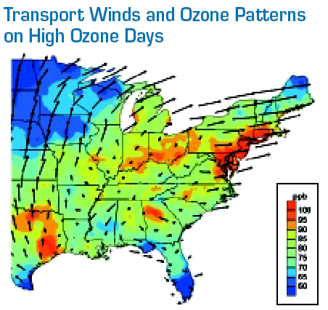What is Interstate Air Pollution Transport?
- local emissions of pollution, and
- upwind emissions of pollution -- pollution emitted at another location (upwind) that is then blown by wind to another location (downwind). Some upwind emissions may come from a different state.
Interstate air pollution transport refers to pollution from upwind emission sources that impact the air quality in a different state downwind.
Emissions of sulfur dioxide (SO2) and nitrogen oxides (NOX) from upwind sources can undergo chemical reactions in the atmosphere to form fine particle (soot) pollution. Similarly, NOX emissions can react in the atmosphere to create ground-level ozone (smog) pollution. These pollutants can travel great distances (i.e., hundreds of miles), affecting air quality and public health regionally. The transport of these pollutants across state borders, referred to as interstate air pollution transport, can make it difficult for downwind states to meet health-based air quality standards for PM2.5 and ozone.

